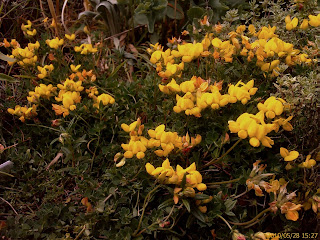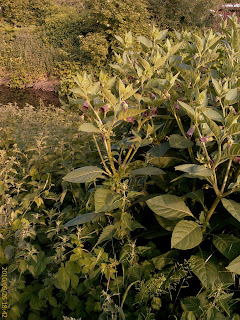Common Blue Damselflies were by the ponds here, on the west side of the Abbey, close to Abbey Rd.
Yellow Archangel was in flower in the wood.
In the afternoon I walked out to the sea wall at Crossness.
On the 'southern marsh' part of Erith marshes, south of Eastern Way, 1 Whitethroat was seen, 2 Swift, a Heron and a flock of 30 Starlings. There was a male Azure Damselfly along shrubbery at the foot of the road bank.
 There were around 17 individual plants of this showy, possibly non-native, Spurge which I have yet to identify, close to where the footpath passes comes out onto Eastern Way.
There were around 17 individual plants of this showy, possibly non-native, Spurge which I have yet to identify, close to where the footpath passes comes out onto Eastern Way. On banking along Eastern Way itself, towards the junction with Yarnton Way, was this splendid show of Common Poppy (Papaver rhoeas), some with very strong black basal blotches, others with none.
On banking along Eastern Way itself, towards the junction with Yarnton Way, was this splendid show of Common Poppy (Papaver rhoeas), some with very strong black basal blotches, others with none. And this superb display of Ox-Eye Daisy flowers.
And this superb display of Ox-Eye Daisy flowers. The new Crossness Sewage works in the distance, beyond Flag Iris and Reeds.
The new Crossness Sewage works in the distance, beyond Flag Iris and Reeds.
 Only my second record of Shining Crane's-bill (Geranium lucidum) in Bexley Borough. Several plants were found on the river side of the hedge between the sea wall and the golf driving range just west of the old Crossness works.
Only my second record of Shining Crane's-bill (Geranium lucidum) in Bexley Borough. Several plants were found on the river side of the hedge between the sea wall and the golf driving range just west of the old Crossness works.
Birds along the foreshore included 7 (possibly 9) Common (probably) Terns, 50 starlings, 38 Shelduck oppositte new Crossness, about 8 Gadwall in the outfall area and 2 Greenfinch in Elder. A Fox was seen towards the incinerator.
Heading back towards Belvedere a Kestrel was seen near an old factory.
There were two young Foxes at dusk on Halt Robin Lane.
Cutting across Franks Park, heading towardd Brook Street, there were 2 small Bats towards the Fox House Rd exit onto Erith Rd, and another near the exit itself.





































